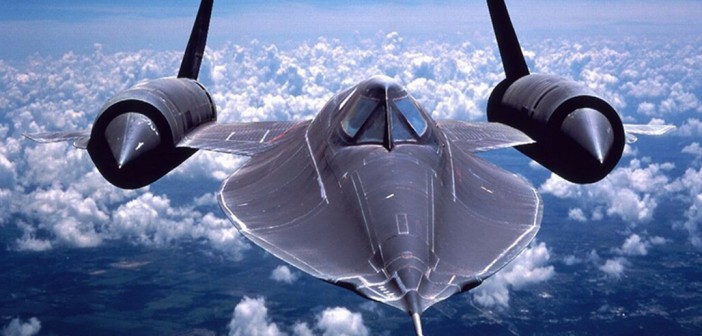Speaker: LtCol. Maury Rosenberg, USAF (Ret)
Gramps was delighted to have USAF Lt. Col Maury Rosenberg, (Ret) as our speaker last month. His subject was the magnificent SR-71, a Mach 3 cruise machine that took pictures, and created radar images and searched for enemy electronic emissions. He had 1090 operational hours in the SR-71 A, B, and C aircraft. Additionally he flew 212 missions in the F-4 C, D and E models in Vietnam. After retirement from the USAF, he flew for United Airlines for a total time of over 38 years in aviation.
The SR-71 was a Mach 3 aircraft with cruise performance at that speed and a design limit of Mach 3.3. That results in flight at 2200 miles per hour or 36 miles per minute. It operated very comfortably at 80,000 feet altitude. The SR was designed and built by Lockheed and was constructed of 93% Titanium that was purchased from Russia (!) by the CIA. It was our first stealth aircraft. The leading edges were designed of honeycomb material to reduce the radar reflection and the rudders were slanted inward for the same reason.
It was made black in color to help dissipate the friction heat that produced extreme temperatures at high speeds. This was necessary even in the upper atmosphere where the temperature was -70 degrees centigrade. It was thus nicknamed the “Blackbird”. The aircraft would expand 3-4 inches in length as the fuselage heated to 600 degrees. The windows would reach 620 degrees and could not be touched for more than 30 seconds even with Nomex pressure suit gloves.
The propulsion system consisted of engines that used JP-7, a very flame resistant fuel that required great heat to ignite. To provide that heat TEB, tri-ethyl boron, was used which was an extremely flammable substance that was injected to provide starting heat for the JP-7. Each engine produced 35,000 pounds of thrust for a total of 70,000 pounds which gave the aircraft a thrust to weight ratio of close to one. If you do not like the price of Av Gas now, think of what it took to buy 40,000 pounds of JP-7 for takeoff with half fuel! Its maximum takeoff fuel weight was 95,000 pounds of JP-7.
The crew consisted of one Pilot and one Reconnaissance Systems Officer who did not have access to the flight controls. They were clad in Full Pressure Suits that would protect them for an ejection at Mach 3.2 and result in survival at that speed. The suits were made by David Clark and were required at or above 80,000 feet since oxygen masks alone would not provide enough oxygen at that low pressure. They also provided fire protection. The suit design was derived from the Gemini Space Program and they were used in the first space shuttle flight. The crew had use of a periscope that was used to identify the presence of a contrail and to align the rudders.
The reconnaissance equipment was spectacular. The camera would take pictures 72 miles wide and 2000 miles long. The resolution would be 6 inches on the ground. The lens to ground distance would be 150,000 feet looking diagonally to the side. The RADAR was ASARS that used a computer enhanced system that gave a radar antenna effective length of one mile. It used ELINT for capture of electronic signals and ANS ASTRO for inertial and celestial navigation with an accuracy of 500 feet. It was equipped with ECM to handle electronic assault attempts.
His career was not without some extraordinary excitement. While flying the SR-71 he had the right engine disintegrate/explode which induced such pitch, yaw and roll activity that the left engine then failed causing depressurization and electrical failure. He then flew visually to the base at Cadena and landed successfully and safely after restarting the left engine. It turned out that the compressor blades had not been tightened appropriately. On another occasion he was flying near the Korean DMV when a missile from the ground locked onto his aircraft and tracked him. Using jamming technology and making a turn of direction, he escaped the SA-2 missile which blew up about a half mile away. This was during “peace” time.
We are grateful to Maury for his service to our country and for his excellent presentation







